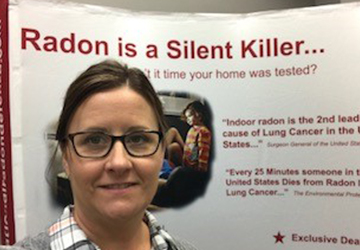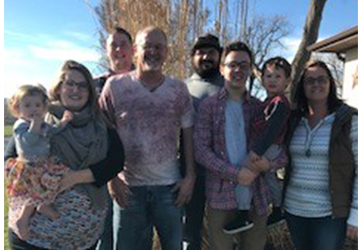
By Kimberly Buchmeier
My name is Kimberly Buchmeier and I am from a small town in Southeast Nebraska. I am a mother, wife, grandmother, daughter, sister, aunt, cousin, friend and a six-year lung cancer survivor. In 2011, at age 37, I was diagnosed with non-small cell adenocarcinoma.
I thought I was pretty healthy. I ran a half marathon the year before, exercise on a regular basis and am not overweight. With three active kids at home and a full time job, I had no time for a cancer diagnosis. I mean, I didn’t feel “sick.” Can you imagine the questions going on in my head? I was young. I was healthy. How could this be?
My oncologist told me that some environmental factors can cause lung cancer. Environmental factors. What environmental factors? I went to Google. Every time I searched “lung cancer from environmental factors” one word stood out in bold…RADON. I ended up finding out, three years after my diagnosis, that radon is the second leading cause of lung cancer. The odorless, colorless gas called radon tests very high in the area where I live. In fact, Nebraska is the third largest state with the highest radon content. With that information, my husband and I tested our home. According to the EPA a home should test below 4 pCi/L.* Our home tested at 14.8 pCi/L. We waited about six months and tested again…29.9 pCi/L! Outrageous!
I discussed this with my oncologist and it was determined that radon was the most likely culprit behind my lung cancer diagnosis.
We installed a mitigation system that controls the radon levels and our home continues to test well under the EPA’s recommendations.

Kimberly and her family.
We built our home in 2003. Never in a million years did I think my beautiful home would be a health hazard. The same year I was diagnosed with lung cancer we lost our seven-year-old dog to cancer. He spent most of his time in our basement bedroom (the highest levels of radon are usually recorded in the basement of a home) and we can’t help but think that radon caused his cancer too. This past year my husband had a CT scan for a separate health issue and it showed small nodules on his lungs. A re-scan after three months showed most of the nodules had disappeared, but now he has to monitor with annual scans. I raised my children in this home and it scares me to death that they, too, were exposed to such high levels of radon.
I advocate constantly for lung cancer awareness and I work with all advocacy organizations to get radon awareness on the map. I urge everyone to test their home, new or old, no matter where you live.
Don’t guess, TEST!
Learn more about lung cancer risk factors, including radon, as well as how to test your home for radon.
*When radiation from radon is measured directly, the amount is usually expressed in picocuries per liter of air (pCi/L). A Curie is a unit of radioactivity equivalent to 1 gram of radium and the prefix “pico” means a trillionth. (source: https://www.epa.gov/sites/production/files/2016-12/documents/2016_a_citizens_guide_to_radon.pdf)

Thank you Kimberly for bringing attention to Radon as the silent killer. I was diagnosed in May of 2012 with NSCLC Stage IV Adenocarcinoma. My brother passed away of lung cancer in 2005. I was not surprised when I too was diagnosed in 2012 although I have never been a smoker. We grew up playing in the basement of our Wisconsin home. The Doctors now feel that we both contacted it many years ago playing in that basement and probably due to exposure to Radon. My brother only survived 20 months past his date of diagnosis. It will be 6 years for me in May and I am doing well. I retired 6 months after my diagnosis. At that time I sent an email to many of my colleagues across the Country to ask them to please have their homes tested for Radon. I heard back from three of those people that they tested and their houses tested high for Radon. I felt that I had really made something good come out of this horrible disease. I will never stop telling my story and I hope you won’t either.
Really interesting article to read. Thank you very much for sharing such an interesting article with us. I’m looking forward to reading such amazing articles in the future as well.
Thanks for all the information concerning radon I agree with all the things you mentioned here. Just wanted to say keep up the good work!
By providing information on the risks of radon exposure and the simplicity of testing, this blog encourages every homeowners to prioritize their health and take action to mitigate any potential hazards in their homes. It serves as a valuable reminder to homeowners to be vigilant about indoor air quality and to not overlook the potential presence of radon gas.